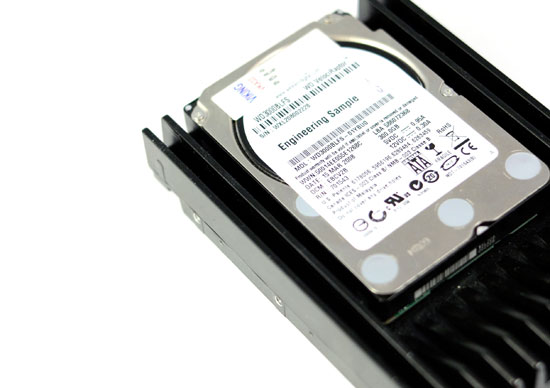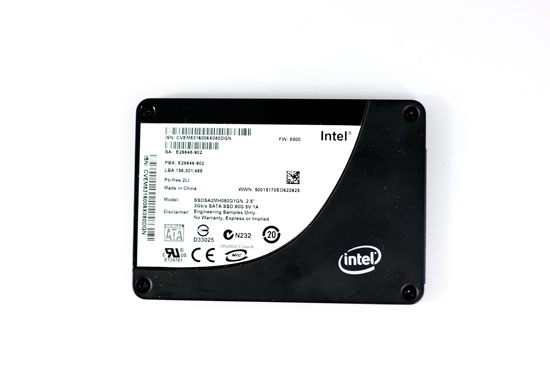The SSD Anthology: Understanding SSDs and New Drives from OCZ
by Anand Lal Shimpi on March 18, 2009 12:00 AM EST- Posted in
- Storage
Why You Should Want an SSD
For the past several months I’ve been calling SSDs the single most noticeable upgrade you can do to your computer. Whether desktop or laptop, stick a good SSD in there and you’ll notice the difference.
I’m always angered by the demos in any Steve Jobs keynote. Not because the demos themselves are somehow bad, but because Jobs always has a perfectly clean machine to run the demos on - and multiple machines at that. Anyone who has built a computer before knows the glory of a freshly installed system; everything just pops up on your screen. Applications, windows, everything - the system is just snappy.
Of course once you start installing more applications and have more things running in the background, your system stops being so snappy and you tend to just be thankful when it doesn’t crash.
A big part of the problem is that once you have more installed on your system, there are more applications sending read/write requests to your IO subsystem. While our CPUs and GPUs thrive on being fed massive amounts of data in parallel, our hard drives aren’t so appreciative of our multitasking demands. And this is where SSDs truly shine.
Before we go too far down the rabbit hole I want to share a few numbers with you.
This is Western Digital’s VelociRaptor. It’s a 300GB drive that spins its platters at 10,000RPM and is widely considered the world’s fastest consumer desktop hard drive.

The 300GB VelociRaptor costs about $0.77 per GB.
This is the Intel X25-M. The Conroe of the SSD world, the drive I reviewed last year. It costs about $4.29 per GB; that’s over 5x the VelociRaptor’s cost per GB.

The VelociRaptor is the dominant force in the consumer HDD industry and the X25-M is the svelte bullfighter of the SSD world.
Whenever anyone mentions a more affordable SSD you always get several detractors saying that you could easily buy 2 VelociRaptors for the same price. Allow me to show you one table that should change your opinion.
This is the Average Read Access test from Lavalys’ Everest Disk benchmark. The test simply writes a bunch of files at random places on the disk and measures how long it takes to access the files.
Measuring random access is very important because that’s what generally happens when you go to run an application while doing other things on your computer. It’s random access that feels the slowest on your machine.
| Random Read Latency in ms | |
| Intel X25-M | 0.11 ms |
| Western Digital VelociRaptor | 6.83 ms |
The world’s fastest consumer desktop hard drive, Western Digital’s 300GB VelociRaptor can access a random file somewhere on its platters in about 6.83ms; that’s pretty quick. Most hard drives will take closer to 8 or 9ms in this test. The Intel X25-M however? 0.11ms. The fastest SSDs can find the data you’re looking for in around 0.1ms. That’s an order of magnitude faster than the fastest hard drive on the market today.
The table is even more impressive when you realize that wherever the data is on your SSD, the read (and write) latency is the same. While HDDs are fastest when the data you want is in the vicinity of the read/write heads, all parts of a SSD are accessed the same way. If you want 4KB of data, regardless of where it is, you’ll get to it at the same speed from a SSD.
The table below looks at sequential read, sequential write and random write performance of these two kings of their respective castles. The speeds are in MB/s.
| Sequential Read (2MB Block) | Sequential Write (2MB Block) | Random Write (4KB Block) | |
| Intel X25-M | 230 MB/s | 71 MB/s | 23 MB/s |
| Western Digital VelociRaptor | 118 MB/s | 119 MB/s | 1.6 MB/s |
If you’re curious, these numbers are best case scenario for the VelociRaptor and worst case scenario for the X25-M (I’ll explain what that means later in the article). While the VelociRaptor is faster in the large block sequential writes look at the sequential read and random write performance. The X25-M destroys the VelociRaptor in sequential reads and is an order of magnitude greater in random write performance. If you’re curious, it’s the random write performance that you’re most likely to notice and that’s where a good SSD can really shine; you write 4KB files far more often than you do 2MB files while using your machine.
If the table above doesn’t convince you, let me share one more datapoint with you. Ever play World of Warcraft? What we’re looking at here is the amount of time it takes to get from the character selection screen into a realm with everything loaded. This is on a fully configured system with around 70GB of applications and data as well as real time anti-virus scanning going on in the background on every accessed file.
| WoW Enter Realm Time in Seconds | |
| Intel X25-M | 4.85 s |
| Western Digital VelociRaptor | 12.5 s |
The world’s fastest hard drive gets us into the game in 12.5 seconds. The Intel X25-M does it in under 5.
SSDs make Vista usable. It doesn’t matter how much background crunching the OS is doing, every application and game launches as if it were the only thing running on the machine. Everything launches quickly. Much faster than on a conventional hard drive. If you have the ability, try using your system with a SSD for a day then go back to your old hard drive; if that test doesn’t convince you, nothing will.
That’s just a small taste of why you’d want an SSD, now let’s get back to finding a good one.










250 Comments
View All Comments
GlItCh017 - Wednesday, March 18, 2009 - link
I just wanted to comment that the backstory portion to this article is simply the most interesting part to an article (or almost even an article inside the main article). On top of that, it is easily the most interesting article I have ever read simply because of that section. Really really must say that I enjoyed reading it!radguy - Wednesday, March 18, 2009 - link
I have been waiting for this one for a while and it was very informative. Thank you very much for it. I did pick up one of the patriot warp drives for my netbook. I was really happy until I installed avg free. So not running an antivirus on it anymore but I have drive image backup incase it goes bad. Overall pretty happy as it was only 80 bucks if I get my mir.I think I'm going to wait until windows 7 till I upgrade my primary desktop. 2 of those vertexs in raid 0 would be sweet though.
sleepeeg3 - Wednesday, March 18, 2009 - link
They were one of the first SSDs you reviewed and they use their own controller. How does their random write performance compare to everything else out now?These reviews made me totally reassess the purchase of the two Samsungs I bought. I had no idea the random writes on the Samsung drives were so bad. Other reviews show the Samsung drives doing better or at least near the X25-M in write tests: http://www.techreport.com/articles.x/15433/6">http://www.techreport.com/articles.x/15433/6 However, those tests probably would have been somewhat sequential.
nubie - Wednesday, March 18, 2009 - link
Grammatically awkward sentence on Page 21:"so if you own one of these drives - you owned a fixed version."
The tense is incorrect (own/owned). I think "own a fixed version" is still awkward, perhaps "you have the fixed version", also the "so" may be superfluous. You can replace the ", so if" with a "; if". Here is how I might re-write the sentence:
"The old firmware never shipped thanks to OCZ's quick acting; if you own one of these drives - you have a fixed version."
(I am not an expert, so feel free to correct me if I am wrong.)
Awesome article btw, thanks for setting me straight on SSD, I have been steering clear of them. I hope soon you can review SSD's and most are good to excellent. :)
Flyboy27 - Wednesday, March 18, 2009 - link
This article has answered every question I've had regarding SSDs recently. Thanks Anand!Flyboy27 - Wednesday, March 18, 2009 - link
If a 120gb Vertex was around $250 I would get one yesterday. I suppose I can wait though.7Enigma - Thursday, March 19, 2009 - link
For me, 2 60's or 2 80's for around that price and I'm sold. Want the Raid0.kgwagner - Wednesday, March 18, 2009 - link
I almost didn't read this article, as everybody and their brother seems to want to explain SSDs these days and most of the articles aren't much more than glorified press releases. But, this one truly took the drives to task and presented some valid information and explanations about the state of the art and where it needs to go. Kudos, Anand. Awesome show. Good job.Mr Perfect - Wednesday, March 18, 2009 - link
"Needless to say, there was some definite fallout from that review. I’m used to negative manufacturer response after a GPU review, but I’m always a bit surprised when it happens in any other segment."Obviously you can't make a business out of irritating manufacturers, but when there really are issues, the readers want to know about them. After all, that's why we come here!
gwolfman - Wednesday, March 18, 2009 - link
You own Anand. Keep up the good work. I've seen you cited from many sites about the work you've done, in particular with SSDs. Best article I've read in months!